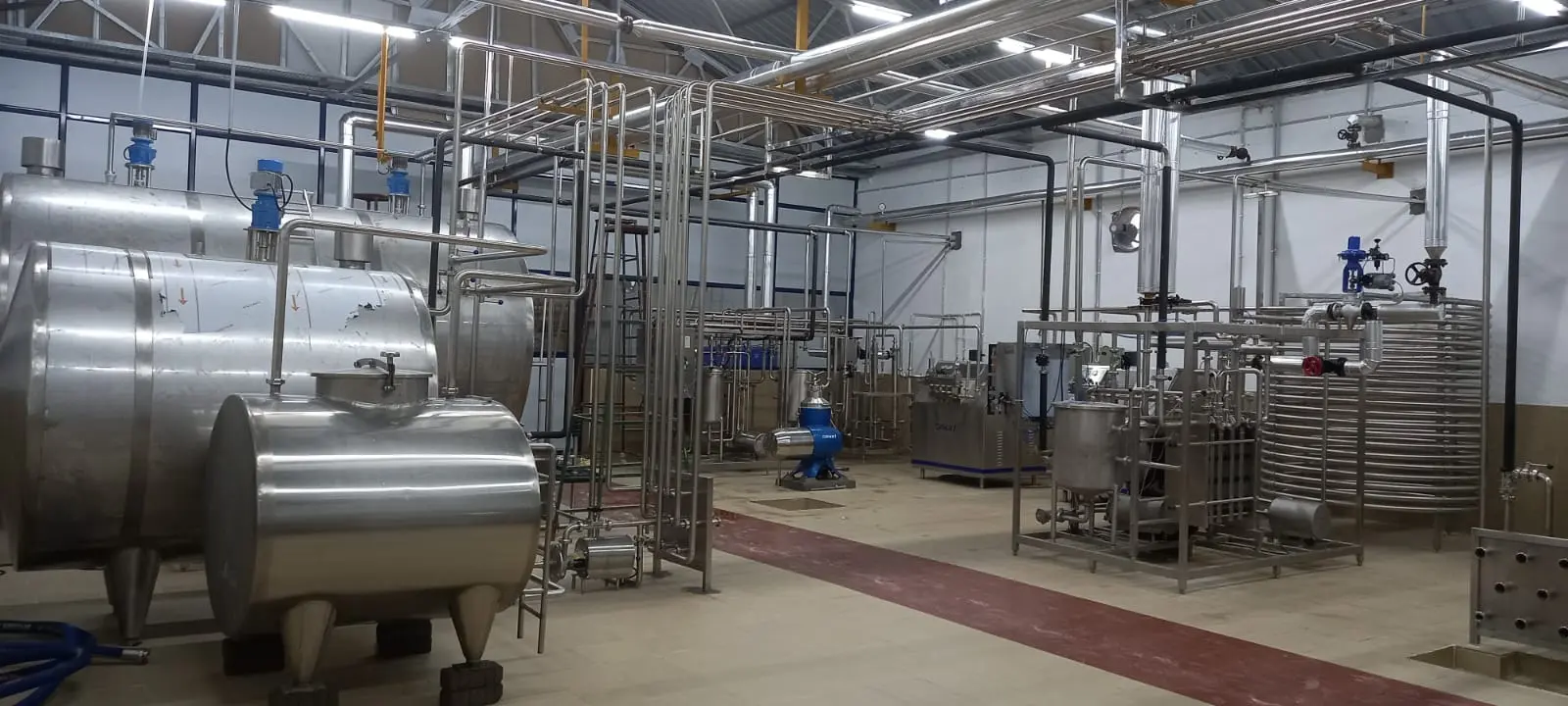Milk Processing Unit
Milk processing is a crucial industry that converts raw milk into a variety of dairy products, such as whole milk, butter, cheese, yogurt, and ice cream. This involves steps like collection, standardization, pasteurization, homogenization, and packaging. The process enables the production of diverse, nutritious, and flavourful dairy items that cater to consumer preferences.
MILK PROCESSING UNIT

Milk:
Milk is a good source of several essential nutrients, including calcium, vitamin D, protein, and various vitamins and minerals. These nutrients are important for bone health, immune function, and overall well-being. Milk is used to produce a wide range of dairy products, including cheese, yogurt, butter, and cream. To ensure the safety of milk and its products, it is often pasteurized, a process that involves heating the milk to kill harmful bacteria and pathogens. The consumption of milk and dairy products varies widely across different cultures. In some regions, milk is a dietary staple, while in others, it plays a more limited role in traditional diets. It's important to note that milk and its derivatives play a significant role in nutrition and agriculture worldwide, and the choice of milk consumption or alternatives depends on individual dietary preferences and health considerations.
Milk Processing:
Milk processing involves a series of steps to transform raw milk from the farm into various dairy products suitable for consumption. These steps are designed to ensure the safety and quality of milk and its derivatives.
Key processes involved in milk processing:
- Milk Collection: Farmers or dairy cooperatives collect raw milk from dairy animals, such as cows, goats, or sheep, and transport it to the dairy processing facility. The milk is typically stored in refrigerated tanks to maintain its freshness.
- Reception and Testing: Upon arrival at the processing plant, the milk undergoes testing to check for quality, temperature, and any signs of contamination. It is also measured for components like fat content.
- Pasteurization: Pasteurization is a crucial step in milk processing. The milk is heated to a specific temperature for a certain duration to kill harmful bacteria, pathogens, and spoilage microorganisms while preserving its nutritional value. There are different pasteurization methods, including high-temperature short-time (HTST) pasteurization and ultra-high-temperature (UHT) pasteurization.
- Separation: After pasteurization, the milk may be separated to remove cream, resulting in skim milk and cream. This separation allows for the production of different dairy products with varying fat contents, such as whole milk, low-fat milk, and cream.
- Homogenization: In this step, the milk is forced through a homogenizer, which breaks down fat globules into smaller, more uniform sizes. Homogenization helps prevent the separation of cream from the milk and improves the texture and consistency of dairy products.
- Standardization: Standardization is the process of adjusting the fat content of the milk to meet specific product requirements. For example, to make whole milk, cream may be added back to skim milk in precise proportions.
- Cooling: The milk is rapidly cooled after pasteurization and other processing steps to reduce the risk of bacterial contamination and maintain freshness.
- Packaging: Processed milk is then packaged in various containers, such as bottles or plastic pouches to maintain quality and safety.
- Storage and Distribution: Processed milk is stored in temperature-controlled environments to maintain its freshness and quality. It is then distributed to retailers, supermarkets, and consumers for sale.
Milk Processing Solutions:
We, at We Smart Engineering, stand as a global leader in providing cutting-edge and high-quality dairy equipment tailored to meet the dynamic requirements of the dairy industry. Our unwavering dedication to excellence has positioned us as a reliable partner for dairy farmers and processors across the globe.
Specializing in turnkey projects for Milk Processing Units, we offer a comprehensive range of key equipment designed to optimize dairy processing operations. Our expertise encompasses the following essential components:
- MILK RECEPTION EQUIPMENT
- Dump Tank
- Filters
- Weigh Bowl
- Milk Pump
- Milk Chillers
- Milk Storage Tanks
- Dedicated tanks for both Raw Milk and Processed Milk to ensure optimal storage conditions.
- Milk Pasteurizers
- State-of-the-art equipment to effectively pasteurize milk, maintaining quality and safety standards.
- Milk Homogenizers
- Precision technology to homogenize milk, enhancing product consistency and quality.
- Cream Separators
- Efficient separators to extract cream from milk, supporting the production of various dairy products.
- Packaging Machines
- Cutting-edge machinery for efficient and hygienic packaging, ensuring product integrity.
- Cold Storage
- Purpose-built facilities for the preservation of dairy products, maintaining freshness and quality.
- CIP Systems (Clean-in-Place)
- Automated systems for thorough and effective cleaning, ensuring hygiene and compliance with industry standards.
At We Smart Engineering, we go beyond providing equipment; we offer turnkey solutions that encompass design, installation, and ongoing support. Our commitment to innovation and quality empowers dairy businesses to thrive in a competitive market. Trust us as your partner in achieving operational excellence and delivering top-notch dairy products to consumers worldwide.